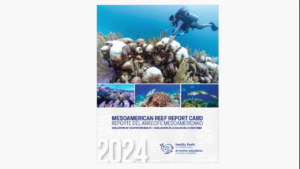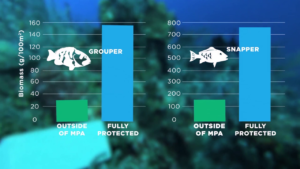Belize’s Reefs Improving but Still Need Saving
Today marked the unveiling of the 2024 Mesoamerican Reef Report Card by Healthy Reefs for Healthy People. This comprehensive report, crafted in collaboration with over seventy dedicated organizations, highlights the ongoing efforts to preserve the stunning reefs of Mexico, Belize, Guatemala, and Honduras. This regional initiative not only offers invaluable data but also champions ecosystem-based management and adaptive conservation strategies for the Mesoamerican Reef. For an in-depth look at today’s launch, News Five’s Britney Gordon was in attendance.
 Britney Gordon, Reporting
Britney Gordon, Reporting
A glimmer of hope shines on the Mesoamerican Reef as its health shows improvement for the first time in five years. While this marks a step in the right direction, the overall grade still hovers in the ‘poor’ category. At the launch of the Mesoamerican Reef Report, Raphael Martinez, the Country Coordinator for Healthy Reefs for Healthy People, provided an in-depth look at the report’s findings.

Raphael Martinez
Raphael Martinez, Country Coordinator, Healthy Reefs for Healthy People
“This year’s report card showed an improvement in the reef health index going from two point zero to two point five. It’s still classified the least in the poor category, but the silver lining is it’s an improvement. It’s a significant improvement, especially looking at indicators of the herbivorous fish and commercial fish biomass that saw a rebound from 2021 numbers. So this is a good sign and we believe that there’s more improvements that could be made in terms of reef health. And we hope to have a collaborative effort across our local network of partners in terms of addressing this issue of trying to improve reef health.”
The health grade of the reef is alarmingly poor, with a significant portion of the two hundred and eighty-six monitored sites falling into the ‘poor’ or ‘critical’ categories, at thirty-nine percent and twenty-three percent, respectively. However, there’s a silver lining: sites in fair condition have increased by eight percent, and those in good condition have risen by three percent. Despite these improvements, two sites remain in critical condition.
 Raphael Martinez
Raphael Martinez
“A major challenge right now, especially affecting the coral reef, is the high level of heat stress. NOAA announced the fourth global coral reef bleaching event and we’re still feeling the effects of that in 2024. This has significantly affected the coral cover within the country and across the entire Mesoamerican region. And this is the main result of climate change and climate change, accompanied with other stressors that we as humans may introduce into the environment being poor water quality, being environmental degradation. You know, this also helps to reduce the reef, the health of the reef. And it’s important for us to address across sectors, different issues that could help to improve it. So water quality being, improving water quality will help to make the reefs more resilient to different stressors being introduced.”
One of the standout findings of the report was the increase of fish population. Commercial fish biomass increased by forty percent, largely due to stronger enforcement measures and herbivorous fish biomass also saw a thirty percent rise. The population of larger fish species, such as snappers and groupers, remains concerning, emphasizing the need for more fishing regulations and community management initiatives. Doctor Jake Snadden, Director of the Environmental Research Institute at the University of Belize tells us how his team works to break down the data for stakeholders.

Jake Snadden
Dr. Jake Snadden, Director, Environmental Research Institute, U.B.
“We’ve been looking at what that data structure is and building the supplementary for the data. So the report card presents a summary value, Healthy Reef Index, if you like, so it’s come up this year. But what does that mean on the ground between the different sites? So, say, if you’re looking at Turneffe Atoll, so you’ve got a whole bunch of sites that are surveyed there. Which sites are going up? Which sites are going down? And that’s the sort of level of information that you can use for adaptive management. And so we’ve been working with the data that’s sort of underneath these scores, if you like, putting that science rigor into it.”
Pinpointing areas for improvement through detailed data analysis is a cornerstone of the co-management system. This approach ensures that reefs and protected areas receive the tailored protection they need.
 Dr. Jake Snadden
Dr. Jake Snadden
“So if you look at the report card and you like what you see, or you don’t like what you see, and if things are decreasing, you can say, where are these patterns happening? What the story behind the data? So then you look in the supplementary document, and in the supplementary document, you can then start to unpick where it is. And this is really important for like protected area managers or co-managers for areas where they’re looking at what’s happened to their reef. Don’t just look at the one value score. Look at what’s happening at the site level. Then you know which sites are improving, which sites are not improving, which sites have large fish biomass, and so they’re doing well, which sites don’t, are there, is there good seagrass, is there good reef structure where you have high, you can get at the science questions behind the management.”
With the data secured, the next step is a call to action. The Healthy Reefs for Healthy People is advocating for the protection of more areas and stricter regulations on fishing. Britney Gordon for News Five.







Facebook Comments